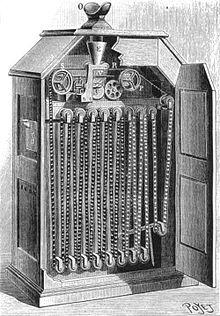Kinetoscope
The Kinetoscope (Greek kinesis , movement, skopein , see) is the first film viewer and was developed in 1891–92 by William Kennedy Laurie Dickson , chief engineer at Edison .
functionality
In this peep box, longitudinally split 2¾-inch celluloid film, i.e. 1⅜- inch wide film, was shown in an endless loop up to a chain (= 66 feet, which corresponds to approx. 20.12 m) to exactly one viewer, who was shown through an eyepiece (display column ) had to look. The film strip was set in motion by an electric motor. The Kinetograph , also developed by Dickson, was used to record the films . While the kinetograph has a ratchet mechanism, the film in the kinetoscope rolls continuously. A circular screen with slits releases the light of an incandescent lamp under the film for a very short time. One looked at a translucent, opaque film positive in front of the light source. In the “studio” set up especially for the project, the Black Maria , the film was shot in sunlight in front of roofing felt. Accordingly, the actors in Edison's films stand out against a black background. A peculiar sculpture distinguishes these pictures from others.
history
Edison's kinetoscope was first presented during the 1893 World's Fair in Chicago. Based on the jukebox predecessor phonograph parlors , the commercial use of the kinetoscope began the following year with the establishment of kinetoscope parlors . On April 14, 1894, the first of these kinetoscope salons opened on Broadway in New York . It was equipped with ten of these showcases, each showing a different film from the Edison Manufacturing Company , including the Blacksmith Scene . For an admission price of 25 cents, visitors to this forerunner cinema were able to use five cinetoscopes. A little later, more Kinetoscope salons opened in Chicago and San Francisco, before other cities in the United States and Europe followed.
In 1895, the Cologne chocolate producer Ludwig Stollwerck founded the "Deutsch Oesterreichische Edison Kinetoskope Compagnie" together with his business friend Thomas Alva Edison and shortly afterwards presented the world's first short films in Germany.
Edison also equipped his kinetoscope with a phonograph that played sounds that match the moving images, such as singing. The device assembled in this way was called the kinetograph (sometimes used as the term for the device for recording the images of the kinetoscope).
Movies
The films produced for the Kinetoskop include:
- Carmencita (film) , 25 seconds
- Dickson Greeting
- Fred Ott's Sneeze
Timetable
- from 1600: Flip book - flip book with individual images
- from 1671: Laterna magica - magic lantern: early device for image projection
- from 1825: Thaumatrop - miracle disc with two threads
- from 1830: Phenakistiskop - phantascope, miracle wheel or wheel of life
- from 1832: stroboscope - magic disks: flash unit
- from 1834: Zoetrop - miracle drum with slots
- from 1861: Mutoskop - stereo animation sheets per stroboscope
- from 1877: Praxinoscope - electrical high-speed viewer using a mirror arrangement
- from 1879: Zoopraxiskop - projection device for chronophotographically generated serial images
- from 1880: Kaiserpanorama - popular mass medium with stereoscopic picture series
- from 1886: Electrotachyscope - projection device for row images
- from 1891: Kinetoskop - first film viewer
See also
- Kodak : William KL Dickson & George Eastman
- Bioscope (projection apparatus with two 54 mm film loops)
- Cinematograph (apparatus from the Lumière company: film camera, copier and film projector in one)
Web links
- The cinema - the development of the 'film' and the 'kinetoscope' ( Memento from May 11, 2012 in the Internet Archive )
- Photography, film and television ( Memento from May 20, 2012 in the Internet Archive )
- Biography of William Kennedy Laurie Dickson , accessed January 2, 2014
Individual evidence
- ^ Edison's Kinetoscop In: Deutsche Verkehrsblätter, 1895, pp. 24-26
- ↑ Lee Grieveson / Peter Krämer (eds.): The Silent Cinema Reader . Routledge, London 2004, ISBN 0-415-25284-9 , p. 12. ( online at Google Books )


